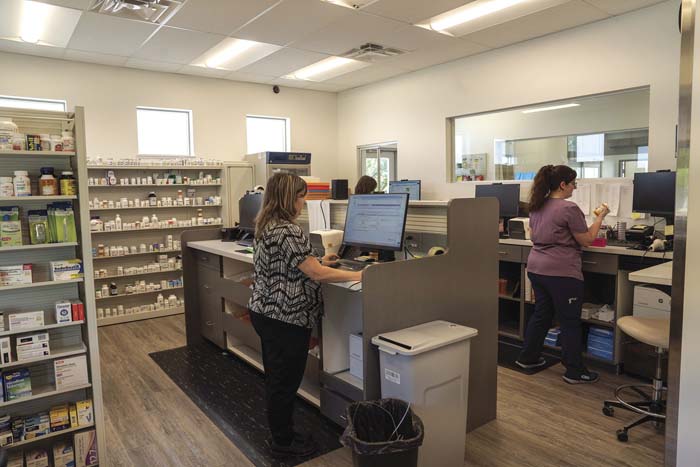Developing a workforce for rural health care meets critical need
Published 5:00 am Wednesday, July 3, 2024

- Winding Waters pharmacy employees prepare medications for patients June 18, 2024, at the recently-opened independent pharmacy in Wallowa County.
One of the most critical needs in rural health care is maintaining the workforce, according to Meredith Lair, director of the Northeast Oregon Area Health Education Center.
Trending
This need is what makes the idea of building educational pathways in Eastern Oregon so vital, she said. Lair, who is the executive director of the Northeast Oregon AHEC, focuses much of her work on developing interest in pursuing health care work as well as supporting health care professionals through educational programs and their careers.
“It’s really challenging to keep clinics open if there aren’t medical assistants or front desk folks or whatever,” Lair said, “particularly in our region, where it’s challenging, if not impossible, to export learners to go get the education that they need and then expect them to come back.”
Workforce needs in health care aren’t specific to Eastern Oregon, as many of the same issues affecting Portland and Eugene also affect Pendleton and Baker City. Costs are high, training is a time-consuming and long-term investment, and attracting people for the long haul is challenging. However, the outlook of life and work in rural areas likely makes some of these challenges more complex.
Trending
Organizations such as the Northeast Oregon AHEC as well as providers in Eastern Oregon are trying to meet the need for health care workers, with exposure and education being central in their efforts.
Meeting workforce needs through education
Clinics and hospitals will not run without staff working at every level, Lair said, such as janitors, medical assistants, administrators, nurses and doctors.
“It makes the idea, the concept, of growing our own even more important,” Lair said.
Northeast Oregon AHEC has been working with local hospitals, she said, such as Grande Ronde Hospital in La Grande and Good Shepherd Medical Center in Hermiston, to start developing younger, entry-level workers with the goal of them staying long term. Developing workers to meet all levels of need in rural health settings is one of the main goals of the AHEC.
“We really are looking from pathway to practice,” Lair said. “How do we start here and get here and then provide that ongoing support? But it’s a big region and so it’s impossible to be everywhere all at once.”
AHEC’s MedQuest Health Career Exploration Camp is a program to help tackle the problem. It’s a summer camp that started 30 years ago in La Grande for 40 high schoolers interested in pursuing health care careers. There now are three versions of the camp for different geographic areas or cultural groups.
During the week-long camp, students have tailored experiences in health care settings. Each person participates in three job shadows in health care areas they’re interested in. Lair said the students get hands-on experience, such as learning how to take vitals or practice extracting a person from a vehicle.
In addition, there are near-peer counselors who have either been campers or are in a health professions program and can give campers advice and insight. This form of mentorship is helpful in community building, Lair said, which can be vital for people pursuing careers in health care.
The camp is an important piece of encouraging prepared applicants, she said.
“Our students are just not competitive applicants, or that’s not the rule,” she said. “Even students whose parents are in health care don’t or can’t always compete with a student who’s coming from a more urban place.”
There are limited spots in schools with health care tracks in the region, and outside of the region, in areas such as Portland, home of the only public medical school in the state (Oregon Health & Science University), it’s particularly competitive.
“It takes a lot of uplifting from many people to prepare a student to go on to apply to medical school, even nursing school to some degree, because spots are so limited in our region,” Lair said.
Incentivizing rural practice
After students leave for school, it can be hard to get them to come back. To address this, OHSU has started the Scholars for a Healthy Oregon Initiative, a scholarship fund to encourage students to work in rural areas. It offers full tuition and covers fees for students who agree to work in rural areas for one year longer than they receive funds.
Medical students, who are in school for four years, for example, would commit to working for five years in a rural area if they received funding throughout school.
The scholarship applies to doctorate health programs such as medical, dental, physician assistant and doctor of nursing practice programs. Students from rural backgrounds or who studied in rural areas receive special consideration for the scholarship.
“The students who have successfully received this scholarship, at least one a year, are all people who intended to practice in our communities, and what the scholarship did was give them the opportunity to do that without the burden of debt,” Lair said. “Whether they’re a physician assistant, some kind of doctoral prepared nurse or a physician, it’s been really critical for our region.”
Meeting workforce needs through precepting
Many students pursuing health care careers — even those who grew up in rural Oregon — don’t want to work in rural areas or face barriers to working in rural areas. Part of this problem is due to the lack of preceptors at various levels of health care providers.
The Northeast Oregon Area Health Education Center identifies people interested in being preceptors and then helps make sure those people and care systems are ready to receive the students “and create a quality experience,” Lair said. That might mean making sure there’s temporary housing available for students who are there for a few weeks or months or offering mentorship to providers who are working with those students.
Local providers also are taking initiative to fill workforce needs.
In Wallowa County, Winding Waters Health Center is a federally qualified health center offering primary medical care as well as mental and behavioral health, general dentistry, integrative services and public health services. Its most recent service is an independent pharmacy. Federally qualified health centers such as Winding Waters are nonprofits that serve underserved populations, offer sliding fee scales for comprehensive services and operate under a board of directors.
Nic Powers, CEO of Winding Waters, said their clinics bring in learners at all levels, such as high schoolers interested in health professions, students working toward health degrees or even residents completing specialty training after medical school. The clinic has been hosting medical students since 1992.
Weaving learners into Winding Waters’s work serves two key aims, Powers said: One is bridging the urban/rural divide, which is not as wide as people may think; and two, reliably recruiting skilled clinicians to Eastern Oregon.
“From really the early days of the clinic to now, there’s always been a component of welcoming learners and showing them a glimpse of rural medicine and now other disciplines as well,” he said, “because the providers here have always realized that that’s how you grow the next generation of providers.”
The role of team-based care
Winding Waters hosts medical and physician assistant students on rotations for up to 12 weeks. Such an extended rotation allows the student to become part of the care team, Powers said, and gives them a chance to get a thorough understanding of what it’s like to practice rural medicine.
“It’s been really cool to see the intentional community that’s created out here,” said Megan Pearlman, a second-year physician assistant student at OHSU. “I think when you’re in such a small area where you see your patients at the grocery store, it shouldn’t change the way that you care for or interact with people, but I feel like it’s just a different experience than if you’re in a big city or in a big hospital system.”
Pearlman, who was about halfway through an eight-week rotation at Winding Waters, said she was surprised by how much she enjoyed working in a rural setting and by how many resources the clinic had available to providers and patients. She added that having a longer rotation allows for continuity of care that she hasn’t experienced in other rotations she’s had.
The clinic integrates care across specialties, having dentists and social workers and doctors working as a team to wholly address the needs of each patient. Pearlman said it has been “really cool to see everything working together so seamlessly” to support patients through the coordinated care approach, and she’s learned a lot so far in her rotation.
Pearlman lives just a three- or four-minute drive from the Enterprise clinic. Her housing was organized on her behalf for the entire two months of her rotation. The Northeast Oregon AHEC helps provide the housing for students that makes the program possible.
“What the AHECs do in particular is make sure that there’s housing and support for sort of the travel expenses and other expenses that there are to just make it out here and have a place to stay,” Powers said. “So that’s a really nice thing for us, too, because prior to AHEC housing, learners would stay with a willing and able family or preceptor, but that made it a much shorter experience.”
To host students from OHSU, for example, there also must be someone with the kind of license that student is pursuing. Right now, Winding Waters does not employ a nurse practitioner and therefore cannot host nurse practitioner students.
Powers said a willingness to mentor students isn’t officially a job requirement for Winding Waters, but it is a priority for the clinic’s team. Exposing learners to rural practice helps break down barriers and negate assumptions, he added.
And beyond that, Powers said, exposure reminds learners that rural practice allows them to see a wide variety of concerns, versus a more narrow practice elsewhere. During the past 30 or so years, he said, hosting students and residents has led to recruiting about six doctors to stay on long term.
“I do see that change kind of increasing over time, that people expect to work in a team-based environment,” Powers said. “And so it’s really important that rural practices figure out how to do that, or potential recruits will look around and go, ‘Oh, this is way too lonely. I can’t do all the things that a patient needs.’”
Editor’s Note: This is part two of a two-part story on challenges to health care in Northeastern Oregon. Part one appeared June 29 in the East Oregonian.





